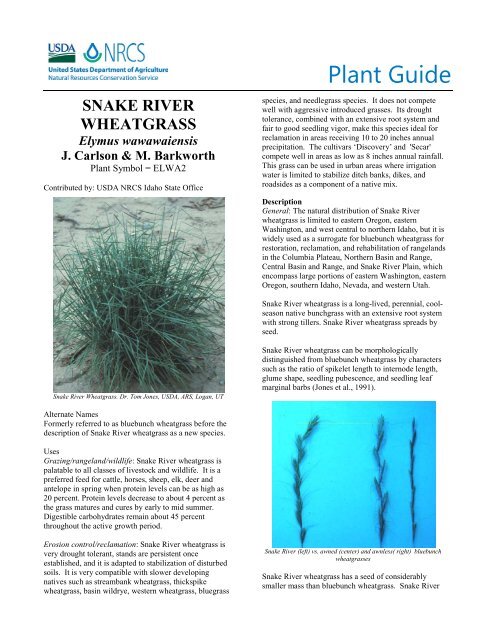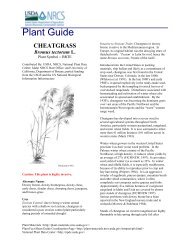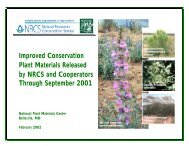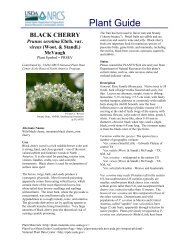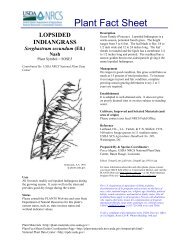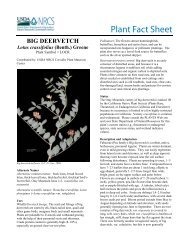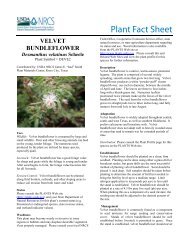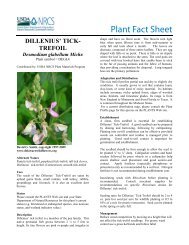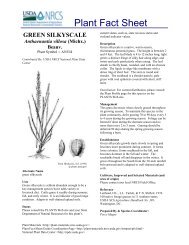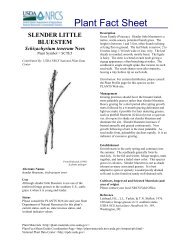Perennial Ryegrass - USDA Plants Database
Perennial Ryegrass - USDA Plants Database
Perennial Ryegrass - USDA Plants Database
You also want an ePaper? Increase the reach of your titles
YUMPU automatically turns print PDFs into web optimized ePapers that Google loves.
SNAKE RIVER<br />
WHEATGRASS<br />
Elymus wawawaiensis<br />
J. Carlson & M. Barkworth<br />
Plant Symbol = ELWA2<br />
Contributed by: <strong>USDA</strong> NRCS Idaho State Office<br />
Snake River Wheatgrass. Dr. Tom Jones, <strong>USDA</strong>, ARS, Logan, UT<br />
Alternate Names<br />
Formerly referred to as bluebunch wheatgrass before the<br />
description of Snake River wheatgrass as a new species.<br />
Uses<br />
Grazing/rangeland/wildlife: Snake River wheatgrass is<br />
palatable to all classes of livestock and wildlife. It is a<br />
preferred feed for cattle, horses, sheep, elk, deer and<br />
antelope in spring when protein levels can be as high as<br />
20 percent. Protein levels decrease to about 4 percent as<br />
the grass matures and cures by early to mid summer.<br />
Digestible carbohydrates remain about 45 percent<br />
throughout the active growth period.<br />
Erosion control/reclamation: Snake River wheatgrass is<br />
very drought tolerant, stands are persistent once<br />
established, and it is adapted to stabilization of disturbed<br />
soils. It is very compatible with slower developing<br />
natives such as streambank wheatgrass, thickspike<br />
wheatgrass, basin wildrye, western wheatgrass, bluegrass<br />
Plant Guide<br />
species, and needlegrass species. It does not compete<br />
well with aggressive introduced grasses. Its drought<br />
tolerance, combined with an extensive root system and<br />
fair to good seedling vigor, make this species ideal for<br />
reclamation in areas receiving 10 to 20 inches annual<br />
precipitation. The cultivars ‘Discovery’ and 'Secar'<br />
compete well in areas as low as 8 inches annual rainfall.<br />
This grass can be used in urban areas where irrigation<br />
water is limited to stabilize ditch banks, dikes, and<br />
roadsides as a component of a native mix.<br />
Description<br />
General: The natural distribution of Snake River<br />
wheatgrass is limited to eastern Oregon, eastern<br />
Washington, and west central to northern Idaho, but it is<br />
widely used as a surrogate for bluebunch wheatgrass for<br />
restoration, reclamation, and rehabilitation of rangelands<br />
in the Columbia Plateau, Northern Basin and Range,<br />
Central Basin and Range, and Snake River Plain, which<br />
encompass large portions of eastern Washington, eastern<br />
Oregon, southern Idaho, Nevada, and western Utah.<br />
Snake River wheatgrass is a long-lived, perennial, coolseason<br />
native bunchgrass with an extensive root system<br />
with strong tillers. Snake River wheatgrass spreads by<br />
seed.<br />
Snake River wheatgrass can be morphologically<br />
distinguished from bluebunch wheatgrass by characters<br />
such as the ratio of spikelet length to internode length,<br />
glume shape, seedling pubescence, and seedling leaf<br />
marginal barbs (Jones et al., 1991).<br />
Snake River (left) vs. awned (center) and awnless( right) bluebunch<br />
wheatgrasses<br />
Snake River wheatgrass has a seed of considerably<br />
smaller mass than bluebunch wheatgrass. Snake River
wheatgrass is always awned, while bluebunch wheatgrass<br />
may be awned or awnless. Snake River wheatgrass is<br />
always allotetraploid (2n=28) while bluebunch<br />
wheatgrass may be diploid (2n=14) or autotetraploid<br />
(2n=28) (Carlson and Barkworth, 1997).<br />
Adaptation and Distribution<br />
Snake River wheatgrass does best on medium to coarsetextured<br />
soils, but can be found on heavy to medium to<br />
coarse-textured soils over 10 inches deep, including fairly<br />
sandy sites. It can be seeded on clayey sites. It may be<br />
found on thin, rocky sites and on very steep slopes. It<br />
tolerates weakly saline conditions. It does not grow on<br />
acidic sites. It is cold tolerant, moderately shade tolerant,<br />
and very tolerant of fire. It is intolerant of high water<br />
tables, poor drainage, and periods of extended inundation.<br />
On native sites Snake River wheatgrass is most abundant<br />
in the 8 to 20 inch annual precipitation zones. When<br />
seeded, it does best with 10 to 20 inches of precipitation<br />
(‘Discovery’ and 'Secar' have established with as little as<br />
7 inches) and it will tolerate up to 35 inches on very welldrained<br />
soils. The elevation range is from 500 feet above<br />
sea level to 10,000 feet. It is a major component of native<br />
plant communities where it is found and generally<br />
occupies 20 to 60 percent of the overall composition by<br />
weight of the plant community.<br />
For a current distribution map, consult the Plant Profile<br />
page for this species on the PLANTS Website.<br />
Status<br />
Consult the PLANTS Website and your State Department<br />
of Natural Resources for this plant’s current status (e.g.<br />
threatened or endangered species, state noxious status,<br />
and wetland indicator values).<br />
Establishment<br />
This species should be seeded with a drill at a depth of 1/2<br />
inch or less on medium-textured soils, 1/4 inch on finetextured<br />
soils and 3/4 inch or less on coarse-textured soils.<br />
The single species seeding rate recommended for this<br />
grass is 8 pounds Pure Live Seed (PLS) or about 24 PLS<br />
per square foot. If used as a component of a mix, adjust<br />
to percent of mix desired. For broadcast plantings, mined<br />
lands, and other harsh critical areas, the seeding rate<br />
should be increased to 40 to 50 PLS per square foot.<br />
Seedlings are significantly weaker than crested<br />
wheatgrass and a clean firm weed free seedbed is required<br />
for establishment (cheatgrass and other weed competition<br />
can cause stand failure).<br />
Seed in very early spring on heavy to medium- textured<br />
soils and in late fall on medium to light- textured soils.<br />
Late summer (August to mid- September) seeding is not<br />
recommended unless irrigation is available. Dormant fall<br />
seedings will pre-chill seed and improve germination.<br />
Snake River wheatgrass establishes fairly quickly for a<br />
native grass and stands should be given up to 3 years to<br />
ensure establishment. It is compatible with other native<br />
species and should be used in seeding mixtures. It should<br />
not be seeded with strongly competitive introduced<br />
species.<br />
Stands may require weed-control measures during<br />
establishment. Application of 2,4-D should not be made<br />
until plants have reached the four to six-leaf stage. Mow<br />
weeds at or prior to their bloom stage. New stands may be<br />
damaged by grasshoppers and other insects and pesticides<br />
may be needed.<br />
Management<br />
Stands of Snake River wheatgrass should not be grazed<br />
until they have firmly established (usually two to three<br />
growing seasons) and started to flower.<br />
Six inches of new growth should be attained in spring<br />
before grazing is allowed in established stands. The<br />
growing point of Snake River wheatgrass is fairly high<br />
and stands can be easily overgrazed. Spring grazing<br />
should occur no more than one out of three years and no<br />
more than 40 percent utilization should occur during rapid<br />
growth. Heavy early-spring grazing is especially<br />
damaging, and grazing should be delayed until flowers<br />
are halfway emerging from the protecting leaf. No more<br />
than 60 percent utilization should occur after seed ripens.<br />
Snake River wheatgrass is not suited to hay production<br />
and is best suited to rangeland, critical area stabilization,<br />
and cropland retirement type uses.<br />
Environmental Concerns<br />
Snake River wheatgrass is long lived and spreads<br />
primarily via seed distribution. It is not considered a<br />
"weedy" or invasive species, but can spread into adjoining<br />
vegetative communities under ideal climatic and<br />
environmental conditions. Most seedings do not spread<br />
from original plantings.<br />
It is a cross-pollinating species and is known to cross with<br />
bluebunch wheatgrass, thickspike wheatgrass, quackgrass,<br />
and bottlebrush squirreltail. These interspecific hybrids<br />
generally exhibit low fertility and do not dominate a site<br />
or crowd out non-hybrid plants.<br />
Seed Production<br />
Seed production of Snake River wheatgrass has been very<br />
successful under cultivated conditions. Row spacing of<br />
24 to 36 inches are recommended under irrigation and 36<br />
inches under dryland conditions. Seeding rates of 3 to 4<br />
PLS per acre are recommended. Cultivation and/or<br />
judicious use of appropriate herbicides will be needed to<br />
maintain rows and weed-free conditions.<br />
Seed fields are productive for three to four years.<br />
Average production of 75 to 100 pounds per acre can be<br />
expected under dryland conditions. Average production
of 250-500 pounds per acre can be expected under<br />
irrigated conditions.<br />
A Snake River wheatgrass seed production field<br />
Dr. Tom Jones, <strong>USDA</strong>, ARS, Logan, UT<br />
Harvesting is best completed by swathing, followed by<br />
combining of the cured rows. The seed heads readily<br />
shatter and require close scrutiny of maturing stands. If<br />
direct combined, harvest at 30 percent moisture and dry<br />
seed down to 12 percent moisture (if stored in bins) or 15<br />
percent moisture (if stored in sacks).<br />
Debearding will be required during processing. Seed is<br />
generally harvested from mid-July to mid-August.<br />
Cultivars, Improved, and Selected Materials (and area<br />
of origin)<br />
‘Discovery’, the second Snake River wheatgrass (Elymus<br />
wawawaiensis) plant material, was released in 2008<br />
(Jones, 2008). It was developed from four accessions that<br />
were found to have improved vigor in comparison to<br />
Secar. These accessions were crossed and seed was<br />
harvested in bulk to generate Discovery.<br />
Discovery was compared to Secar in seeded trials at two<br />
sites in the Intermountain Region and four sites in the<br />
Great Plains (Jones, 2008). Stand frequency of Discovery<br />
in the Intermountain locations for year 2 was 49.3%<br />
compared to 27.4% for Secar. Forage yield of Discovery<br />
for years 2 to 4 was 108.0% greater than Secar. No<br />
significant differences were observed at the Great Plains<br />
locations. Discovery was also compared to Secar in a<br />
transplanted trial at Millville, Utah where it produced<br />
18% greater straw weight across two densities the<br />
summer after establishment.<br />
The populations used to generate Discovery trace to<br />
materials collected in Whitman and Asotin counties in<br />
southeastern Washington and Idaho County in central<br />
Idaho.<br />
Breeder seed is maintained by the <strong>USDA</strong>-ARS Forage<br />
and Range Research Laboratory, Logan, UT, and will be<br />
made available to commercial growers through the Utah<br />
Crop Improvement Association for production of<br />
Foundation, Registered, and Certified generations.<br />
'Secar' is the original cultivar release of Snake River<br />
wheatgrass (Elymus wawawaiensis). It was originally<br />
released as a bluebunch wheatgrass, but cytological<br />
examination later determined it to be Snake River<br />
wheatgrass. The original collection site for Secar is along<br />
the Snake River Gorge near Lewiston, Idaho. The Idaho-<br />
Oregon- Montana-Wyoming AES, Washington<br />
Agriculture Research Center, and Pullman Plant Materials<br />
Center released Secar in 1980.<br />
It is one of the most drought-tolerant native perennial<br />
grasses available and can survive down to 8 inches<br />
rainfall. It is a bunchgrass with fair to good seedling vigor<br />
and establishes well under droughty conditions. While<br />
Secar is considered to be highly drought tolerant as a<br />
mature plant, drought often reduces the stand during the<br />
establishment year. 'Secar' is intended for use on<br />
rangeland for re-establishment of native-plant<br />
communities and for cropland retirement type plantings.<br />
Certified seed is available and Breeder seed is maintained<br />
by Pullman PMC. Foundation seed is available through<br />
the Washington State Crop Improvement Association.<br />
References<br />
Alderson, J. & W.C. Sharp 1994. Grass varieties in the<br />
United States. Agriculture Handbook No. 170.<br />
<strong>USDA</strong>, SCS, Washington, D.C.<br />
Carlson, J.R. & M.E. Barkworth 1997. Elymus<br />
wawawaiensis: a species hitherto confused with<br />
Pseudoroegneria spicata (Triticeae, Poaceae).<br />
Phytologia 83:312-330.<br />
Cronquist, A., A.H. Holmgren, N.H. Holmgren, J.L.<br />
Reveal, & P. K. Holmgren 1977. Intermountain<br />
Flora. Vol. 6. The New York Botanical Garden.<br />
Columbia University Press, New York, New York.<br />
Hitchcock, A. S. 1950. Manual of the grasses of the<br />
United States. <strong>USDA</strong>, Washington, DC.<br />
Jones, T.A. 2008. Notice of release of ‘Discovery’ Snake<br />
River wheatgrass. Native <strong>Plants</strong> J. 9:99-102.<br />
Jones, T.A., D.C. Nielson, and J.R. Carlson. 1991.<br />
Developing a grazing-tolerant native grass for<br />
bluebunch wheatgrass sites. Rangelands 13:147-150.<br />
Miller, R.P., J.M. Seufert, and M.R. Haferkamp. 1987.<br />
The ecology and management of bluebunch<br />
wheatgrass (Agropyron spicatum): A review. Oregon<br />
Agric. Exp. Sta. Bull. No. 669.
Morrison, K.J., and C.A. Kelley. 1981. Secar bluebunch<br />
wheatgrass. EB 0991. Cooperative Extension,<br />
Washington State University, Pullman.<br />
<strong>USDA</strong>, Forest Service 1996. Fire effects information<br />
system. Version: 000413. Rocky Mountain Research<br />
Station, Fire Sciences Laboratory, Missoula, MT.<br />
http://www.fs.fed.us/database/feis/<br />
<strong>USDA</strong>, NRCS 2000. The PLANTS database.<br />
http://plants.usda.gov National Plant Data Center,<br />
Baton Rouge, Louisiana.<br />
Prepared By<br />
Daniel G. Ogle<br />
<strong>USDA</strong>, NRCS, Idaho State Office, Boise, Idaho<br />
Mark Stannard<br />
<strong>USDA</strong>, NRCS, Plant Materials Center, Pullman,<br />
Washington<br />
Dr. Thomas A. Jones<br />
<strong>USDA</strong>, ARS, Forage and Range Laboratory, Logan, Utah<br />
Species Coordinator<br />
Daniel G. Ogle<br />
<strong>USDA</strong>, NRCS, Idaho State Office, Boise, Idaho<br />
Published September 2008<br />
Edited: 091608dgo; 091508ms; 071108taj<br />
For more information about this and other plants, please<br />
contact your local NRCS field office or Conservation<br />
District at http://www.nrcs.usda.gov/ and visit the<br />
PLANTS Web site at http://plants.usda.gov/ or the Plant<br />
Materials Program Web site http://plantmaterials.nrcs.usda.gov.<br />
PLANTS is not responsible for the content or availability<br />
of other Web sites.<br />
<strong>USDA</strong> IS AN EQUAL OPPORTUNITY PROVIDER AND EMPLOYER


